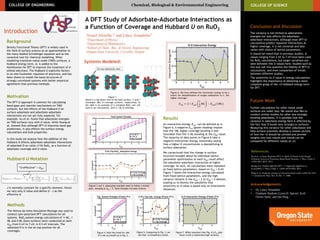PNW-AVS_Poster_Yousif_LA
- 1. COLLEGE OF ENGINEERING Chemical, Biological & Environmental Engineering A DFT Study of Adsorbate-Adsorbate Interactions as a Function of Coverage and Hubbard U on RuO2 Yousif Almulla1,2 and LÃney ÃrnadÃģttir3 1Department of Physics 2Department of Mathematics 3School of Chem., Bio., & Enviro. Engineering Oregon State University, Corvallis, Oregon Results An interaction energy, Eint, can be defined as in Figure 6. A negative Eint (green shading) implies that the 1ML higher coverage bonding is less favorable than the Â― ML bonding at the Ueff value. The majority of data points in Figure 6 take a negative interaction energy, essentially saying that a higher O concentration is destabilizing to surface adsorption. We conjectured that the change in surface structure brought about by individual lattice parameter optimization at each Ueff could affect the adsorbate-adsorbate interaction at higher coverage. As such, all calculations were repeated at fixed lattice parameters, based on Ueff = 0 eV. Figure 7 shows the interaction energy calculated from fixed lattice parameters, and the high variance remains in the Ueff = 2 to Ueff = 5 domain, leading us to dismiss the possibility that sensitivity to U value is based only on interatomic distances. Introduction Conclusion and Discussion The variance is not limited to adsorptions energies but also affects the adsorbate- adsorbate interactions. Although most DFT+U calculations predict repulsive interactions at higher coverage, it is not universal and also varies with choice of lattice parameters. It should be noted that in previous studies, U values ranging from 2 eV to 7 eV have been used for RuO2 calculations, but larger variations are seen between this U values here. Studies such as this one call into question the fidelity of DFT+U calculations, and even comparison of trends between different studies. The sensitivity to U value in energy calculations highlights the importance of obtaining a more complete grasp of the +U Hubbard energy term for DFT. Acknowledgements âĒ Dr. LÃney ÃrnadÃģttir âĒ Graduate Students Lynza H. Sprowl, Kofi Oware Sarfo, and Qin Pang References Xu et al. A Linear Response DFT+U Study of Trends in the Oxygen Evolution Activity of Transition Metal Rutile Dioxides. J. Phys. Chem. C 119(9) 4827-4833, 2015. Huang et al. Surface-Specific DFT + U Approach Applied to Îą- Fe2O3(0001). J. Phys. Chem. C 120(9) 4919-4930, 2016. Wang et al. Oxidation energies of transition metal oxides within the GGA + U framework. Phys. Rev. B. Vol. 17. 2006. Motivation The DFT+U approach is common for calculating band-gaps and reaction mechanisms on TMO surfaces, but the effects of the Hubbard U on surface-adsorbate and adsorbate-adsorbate interactions are not yet fully explored. For example, Xu et al. found that adsorption energies on TMO surfaces vary with U value, while Huang et al. showed that although DFT+U improves band gap predictions, it also effects the surface energy calculations and bulk properties. In this study we analyze how the addition of the Hubbard U affects adsorbate-adsorbate interactions of adsorbed O on rutile (110) RuO2, as a function of adsorbate coverage and U value. Figure 1. Above is a top-down view of the bare surface, Â― and 1 monolayer (ML) O coverage surfaces, respectively. To the right is an example of a complete RuO2 unit cell used in our calculations, with a 1 ML O coverage. Methods The Vienna ab-initio Simulation Package was used to conduct spin-polarized DFT calculations for all systems. RuO2 system energy calculations of Â― ML, 1 ML and 0 ML (bare surface) were conducted at each Ueff from 0 eV to 7 eV, in 0.5 eV intervals. The adsorbed O is in the on-top position for all coverages. On-top adsorption sites. Future Work Further calculations for other metal oxide surfaces are under way. We would also like to conduct similar studies for other less strongly bonding adsorbates. It is possible that the variance in adsorbate energy here is affected by the fact that O bonds very strongly to surfaces. Measuring this variance for other adsorbates will help surface scientists develop a clearer picture of how the +U should be utilized and provide insights into how results and trends can be compared for different values of +U. COLLEGE OF SCIENCE Systems Modeled: Background Density Functional Theory (DFT) is widely used in the field of surface science as an approximation to the many-bodied SchrÃķdinger equation and as the canonical tool for chemical modelling. When modelling transition metal oxide (TMO) surfaces, a Hubbard energy term, U, is added to the Hamiltonian for DFT to improve the treatment of d- orbital electrons. The Hubbard U explicitly factors in on-site Coulombic repulsion of electrons, and has been shown to model the band-structures of strongly correlated systems with better empirical agreement than previous methods. âUâeffectiveâ = Ueff Hubbard U Notation J is normally constant for a specific element, hence we vary only U value and define U â J as the effective U. Figure 6. We have defined the interaction energy to be a metric for destabilization of oxygen adsorption w.r.t. the higher coverage: ðļðððĄ = 2 â ðļ ððð 1 2 ððŋ â ðļ ððð (1ððŋ) Repulsive interactions Attractive interactions Figures 2 and 3. Adsorption energies seem to follow a similar path, merging at Ueff = 5. Total energies increase linearly. Figure 4. Note the trend for 1ML O is not as smooth as in Fig. 2. Figure 5. Comparing to Fig. 3, we see that +U smoothens trends. Figure 7. While smoother than Fig. 6âs Eint plot, there is still a mysterious high variance.
